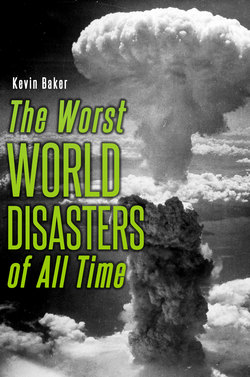Читать книгу The Worst World Disasters of All Time - Kevin Baker - Страница 7
5 – Bengal Famine
ОглавлениеBritish East India Company flag.
Date: 1770 – 1773.
Location: Bengal, India.
Disaster Type: Famine.
Fatalities: 10,000,000 deaths.
Resulting Damage: Large areas depopulated.
Many people in modern times worry about the flu or other similar epidemic events which may hit hundreds of people in a city, but we easily forget about some of the more brutal events that occurred throughout history. One of the worst, yet mostly forgotten events, was the Bengal famine of 1770 – 1773 where 10 million people died, not from a virus but from a lack of proper nutrients. This event occurred in the area of Bengal which at the time was still ruled by the British Empire. The affected region included West Bengal, Bangladesh, Bihar, Jharkhand and Odisha. The people living there used to be part of the Mughal empire, but by the early 1700s they had become tribal people, freed from Mughal rule. This is when the British came and took control of the region.
The controlling power was the British East India Company which was granted full control by the Mughal prince. Throughout the eighteenth century, the British established trade and fought against any opposing local leader, ending with the battle of Plassey in 1757 where Bengal then became fully under the control of London. Due to this new situation, the local villagers saw their agricultural processes modified. The East India Company was interested primarily in profit and exported a majority of the local surplus food supplies. They also imposed very high taxes on the local populations. Finally, a lot of food crops were replaced with opium instead. So in 1769, when a devastating drought occurred, there was simply not enough food to feed everyone. The following year things became even worse and starvation began to set in.
For the best part of two years almost nothing could be grown because of extreme heat and a lack of rain, and as a result deaths started occurring on a large scale, because there were no surplus food supplies available. The selfish policies of the company ensured that the local villagers had no chance of survival during the long drought, until heavy rains returned once again so that the remaining malnourished survivors could grow crops. In all, one third of the population in these regions died from the famine due to poor management from the British Empire, combined with an unusually long drought period.
Large areas became depopulated during the drought, with many survivors understandably abandoning the area affected. During the drought, trade leaders did little to help the local population, instead they increased taxes even more, leading many to despise the British Empire. As a result, the region was kept back from developing for over a decade. This event is even studied in some schools as a lesson on how not to prioritize trading over keeping local surplus food supplies for emergency situations.
